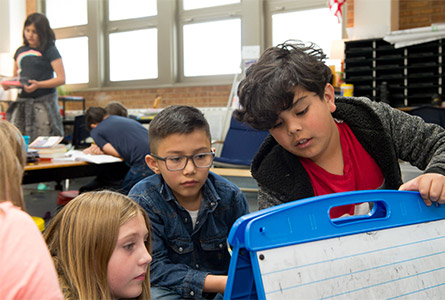“When I switched to workshop model instruction, my students’ math achievement leapt up by 50 percent in a matter of months. I am not kidding. The principal was in my room asking, ‘What is it you are doing in here?’ And I told her, ‘I read this book, and now it’s all about the kids doing the thinking.’ Even I was amazed.” —Elaine Lee, Beach Court Elementary School Teacher
First-Grade Math Workshop
First graders in Carrie Halbasch’s class are gathered together on the rug at the front of the room. “How do mathematicians make sense and solve?” She invites them to share their ideas and records their thinking on a chart.
“Read.”
“Reread and make a picture.”
“Underline important parts.”
“Think: What is known? What is unknown?”
“Use manipulatives, like the Unifix cubes, to make a model.”
After this warm-up conversation about their own strategies for making meaning, Carrie poses a math challenge: 8 + 5 + 7 = ___. “Hmm. How can I solve without counting?” The class reads the problem again together, then Carrie says, “Turn and talk with a partner. We are not solving yet, we are just looking for clues. What do you see that is going to help you solve?” Students go knee to knee and start talking about their ideas, hands gesturing animatedly as they chat. Carrie leans in and listens.
After a few minutes of partner conversation, Carrie reconvenes the group as a collective and invites students to share their thinking:
“What I know is that eight is a part, five is a part, and a plus in the middle means that we need to add.”
“We said that eight, five, and seven are the parts.”
“We drew a picture.” Carrie invites Lucy to share her image with the group. She comes to the Smartboard and sketches:
| 8 | 5 | 7 |
After students hear a few more of their peers’ observations and ideas, Carrie sends them to their tables for some independent work on this problem. “Happy solving!” Learners open math journals, glue in the half sheet with the printed problem, and start to record their thinking. They whisper to one another. Some grab bins of manipulatives to work this out kinesthetically. Others sketch boxes or sticks or other representations as they think through their solutions. A handful, after gluing their papers into their notebooks, return to the rug to request their teacher’s support getting started. Carrie talks through the problem with this small self-selected group, glancing up at the other mathematicians often. After about ten minutes of work time, Carrie calls for all the students’ attention and identifies some of the strategies she is observing. “I see Felipe is using cubes and a balance scale, and Shawnia is drawing rows of dots.” A few students grab new resources and persevere. And just to ensure no one is left at loose ends, Carrie layers in another challenge, holding another half sheet of colored paper in the air. “And this is the ‘push me,’ when that (pointing to 8 + 5 + 7) is done: 18 − 7 ___9 + 7. Make it true. Less than, greater than, or equal? Happy solving.”
Throughout ten more minutes of diligent work time, Carrie moves from table to table, leaning in to confer with individuals and small groups: “Tell me about your thinking.” “Show me how you got that.” “And what are you thinking now?” Soon, with recess looming, Carrie calls all these young mathematicians back to the rug to share. Felipe carries his balance scale to the front of the group and explains his thinking. “I put eight black cubes on one side of the scale, and seven blue on the other side. Then, I broke the five apart to have 8 + 2 and 7 + 3, and that is ten on each side. They are even. It balances.”
“Who sees it?” Carrie asks, and many hands shoot into the air. “What do you see?”
“I see two tens, and it’s equal. And that’s a double.”
“And what did you get?” Carrie prompts Felipe.
“Twenty. 10 + 10 = 20.” Carrie compliments Felipe’s representation of his thinking, pointing out to the group how he used “make it a ten” twice, finding the hidden patterns to make those tens, and used his background knowledge of doubles. Then Jazlyn shows how she had the same idea, but wrote it out numerically.
“So, what helped us solve without counting, in the most efficient way?” she addresses the group, and invites students once again to turn and talk with a partner. They conclude their workshop by going back to the opening question, “How do mathematicians make sense and solve?” The students offer new ideas to add to their chart based on the work today:
- Look for patterns.
- Use background knowledge.
Recess, well earned.
Excerpted from Phenomenal Teaching, just out from Heinemann.
To learn more about Phenomenal Teaching and the PEBC Teaching Framework, please join us for our forthcoming webinar series.

